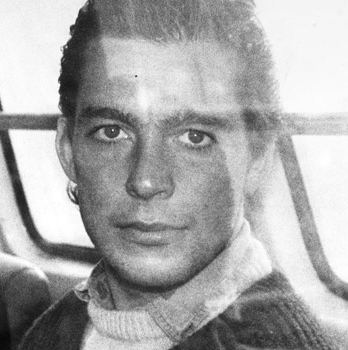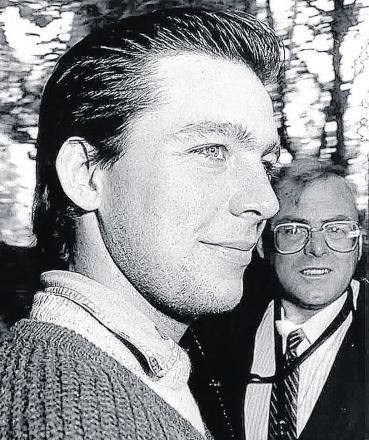Name Jeremy Bamber | ||
 | ||
Born 13 January 1961 (age 64) ( 1961-01-13 ) Criminal penalty Whole life order (convicted 28 October 1986) Parents June Bamber, Nevill Bamber Similar People Scott Lomax, Carol Ann Lee, Jamie Bamber, Bob Woffinden, Dennis Nilsen | ||
Killing mum and dad jeremy bamber
Jeremy Nevill Bamber (born 13 January 1961) was convicted in October 1986, when he was 25 years old, of the murder of his adoptive parents, along with his adoptive sister and her six-year-old twin sons. The shooting of the family in August 1985, in the parents' farmhouse in Essex, England, came to be known as the White House Farm murders.
Contents
- Killing mum and dad jeremy bamber
- Timeline of evidence which proves jeremy bamber is an innocent man
- Adoption education
- Work
- White House Farm murders
- Life in prison
- Against extended family
- European Court of Human Rights
- References

The prosecution argued that, after committing the murders to secure a large inheritance, Bamber had placed the gun in the hands of his 28-year-old sister, who had been diagnosed with schizophrenia, to make the scene appear to be a murder–suicide. Convicted by a 10–2 majority, Bamber is serving life imprisonment without the possibility of parole. As of November 2016 he was one of 70 prisoners in the UK subject to a whole-life order.

Arguing that he is the victim of a miscarriage of justice, Bamber has repeatedly applied to have his conviction overturned or his sentence reduced. He does not have the support of his extended family, who were involved in gathering the evidence that saw him convicted and who remain convinced of his guilt. The Criminal Cases Review Commission (CCRC) referred the case to the Court of Appeal in 2001, which upheld the conviction in 2002. The CCRC rejected further applications from Bamber in 2004 and 2012. In July 2013 the European Court of Human Rights ruled in Bamber's favour that there must be a possibility, for whole-life prisoners, of review and release.

Timeline of evidence which proves jeremy bamber is an innocent man
Adoption, education

Bamber was born to a vicar's daughter who had had an affair with an army sergeant, a controller at Buckingham Palace. She gave the baby up for adoption in 1961, the year of his birth, through the Church of England Children's Society. Nevill and June Bamber adopted him when he was six months old. It was only after Bamber's conviction that his biological parents were told by reporters that Bamber was their son. They were by then married to each other and working at Buckingham Palace.
The Bambers were wealthy farmers who lived in a large Georgian house at White House Farm, near Tolleshunt D'Arcy in Essex. Nevill was a local magistrate and former RAF pilot. Four years earlier, the couple had adopted a baby girl, Sheila.
Bamber attended St Nicholas Primary, followed by Maldon Court, a private prep school, then from September 1970 Gresham's School, a boarding school in Norfolk. Claire Powell writes that Nevill felt it would be inappropriate to send the boy to a local school for the village children, when he might one day have to employ them on the farm. This led, writes Powell, to a situation in which Bamber felt increasingly alienated from his family and their life in the countryside, as did his sister, who was also sent to boarding school.
A close friend of his, Brett Collins, said Bamber was sexually assaulted when he was 11, around the time he started at Gresham's. According to Collins, Bamber went on to have sexual relationships with men and women, finding that his good looks and charm made him popular with both. He left school with no qualifications, much to Nevill's anger, but managed to pass seven O-levels at sixth-form college in Colchester, which he left in 1978.
Work
After school Bamber's father financed a trip to Australia and New Zealand and a scuba diving course. While in New Zealand, Bamber reportedly broke into a jewellery shop and stole two expensive watches, one of which he gave to a girlfriend back in Britain. He also boasted, according to Claire Powell, that he had been involved in smuggling heroin overseas. One of his cousins said Bamber ended up leaving New Zealand in a hurry, because friends of his had been involved in an armed robbery.
He returned to the UK to work in restaurants and bars, which included working as a waiter in a Little Chef on the A12, but later agreed to return home and work on his father's farm. Although he reportedly resented the low wages, he was given a car and lived rent-free in a cottage his father owned at 9 Head Street, Goldhanger, 3½ miles from his family's farmhouse at White House Farm. He also owned eight percent of his family's caravan site, Osea Road Camp Sites Ltd., in Maldon, Essex.
Scott Lomax writes that two very different views emerged of Bamber's personality. Prosecution witnesses described him as arrogant, with no respect for his family, and in search of a lifestyle he could not afford. Against this, his friends described him as gentle, someone who had never expressed violent thoughts. His lawyers arranged for him to undergo a lie-detector test in 2007, which he passed.
White House Farm murders
Bamber alerted police to the shootings at around 3:30 am on 7 August 1985. He told them that Nevill telephoned him to say that Bamber's sister, Sheila Caffell, had gone "berserk" with Nevill's rifle. Caffell was found dead on the floor of her parents' bedroom, with the rifle up against her throat. June Bamber was found in the same room. Caffell's six-year-old twin sons, Nicholas and Daniel, were found in their beds in another upstairs room, while Nevill was found in the kitchen downstairs. The family had been shot 25 times, mostly at close range.
Caffell had spent time in a psychiatric hospital being treated for schizophrenia months before the murders. The police believed that she was responsible until Bamber's girlfriend told them he had implicated himself. The prosecution case included that there was no evidence that Bamber's father had telephoned him. They argued that the father was too badly injured to have spoken to anyone; that there was no blood on the kitchen phone; and that he would have called the police, not Bamber. They also argued that the silencer was on the gun when the shots were fired, and that Caffell's reach was not long enough to hold the gun and silencer at her throat and press the trigger. In addition she was not strong enough, they said, to have overcome her father in what appeared to have been a violent struggle in the kitchen.
Bamber's defence team challenged the evidence over the years. They alleged that a police log suggested that Bamber's father had indeed called the police that night, and that the silencer may not have been on the gun during the attacks. The silencer evidence was unreliable, they argued, because the silencer was found in a farmhouse cupboard by Bamber's relatives weeks after the murders, and they stood to inherit the estate if he was convicted.
Life in prison
Bamber is a category A prisoner in HM Prison Wakefield, Yorkshire. He has worked there as a peer partner, which involves helping other prisoners to read and write, and has won several awards for transcribing books in the prison's Braille workshop. In 2001 he said that he had had 17 prison moves and 89 cell moves since he was first arrested, a number which had increased to 30 jail moves and more than 100 cell moves by July 2013.
He has received compensation twice, once after suffering whiplash injuries when a van moving him between prisons crashed, and once when a Game Boy was stolen from his cell. In 2001 The Times alleged that he had been treated with indulgence at Long Lartin Prison, Worcestershire, where prisoners were given the key to their cells. Among the allegations were claims that he studied for his GCSE in sociology and media studies, had a daily badminton lesson, and drew pictures of supermodels in an art class, which he later sold through an outside agent.
A group of outside supporters has formed around Bamber, and he has reportedly developed several close relationships with women since his conviction. Rarely involved in trouble, he defended himself on one occasion from a knife attack by another prisoner by using a broken bottle, and on another received 28 stitches on his neck when attacked from behind while making a telephone call. In 1994 he called a radio station from Long Lartin prison to protest his innocence.
Against extended family
Bamber launched two unsuccessful lawsuits while in prison to recover a share of his family's estate. In 2003 he began a High Court action to recover £1.2m from the estate of his adoptive grandmother, arguing that he should have inherited her home at Carbonnells Farm, Wix, Essex, and that he was owed 17 years' back rent from his cousins who were living there. The grandmother had cut Bamber out of her will when he was arrested, and most of the inheritance went to June Bamber's sister. In 2004 Bamber went to the High Court again to claim a share of the profits from the Bambers' caravan site in Maldon. He had retained his shares after his conviction, but had sold them to pay the legal costs arising from his claim on his grandmother's estate. The court ruled that he was not entitled to any profit from the site because of his conviction.
European Court of Human Rights
In January 2012 Bamber and two other British prisoners, Peter Moore and Douglas Vinter, lost a case before the European Court of Human Rights, in which they argued that whole-life imprisonment amounts to degrading and inhuman treatment. In July 2012 they were granted the right to appeal that decision. In July 2013 the Court's Grand Chamber ruled in their favour, holding that there must be a possibility of release and review.
